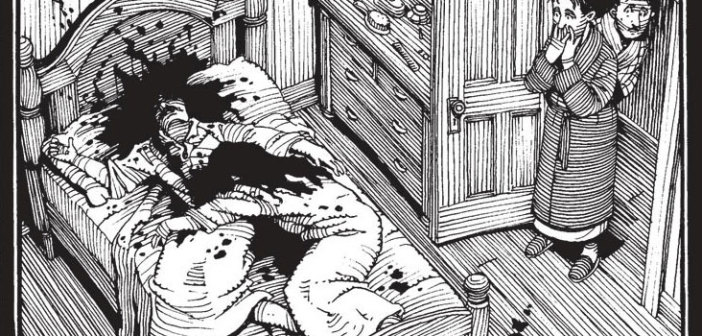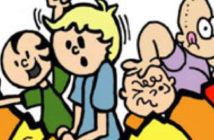There’s an eerie quiet that hangs over the pages of Rick Geary’s The Terrible Axe-Man of New Orleans, an eerie quiet that can only be found in a story that’s fact rather than fiction. Geary, writer and artist both, is known for his nonfiction comics about mysterious murders taking place during the Nineteenth and Twentieth Centuries: the series is called “A Treasury of XXth Century Murder,” and this volume is his latest in it.
In the book, Geary tackles the diabolical Axe-Man who walked the streets of New Orleans from May 1918 to October 1919. Nearly all of the Axe-Man’s victims were both Italian immigrants and grocers, though there are some deviations here and there from the killer’s modus operandi. The first victim was Joseph Maggio, who was brutalized late at night on 22 May 1918 while he slept alongside his wife. An axe was repeatedly taken to his head, and though he didn’t die initially, he drew his last breath only minutes after being discovered by his brothers.
With this initial murder, the killer began to build an identity for himself based upon his murderous habits. He always used a weapon owned by his victim (preferably an axe), leaving it at the crime scene. In the case of the Maggio murder, the axe was dumped in the victim’s bathtub. A safe was cracked open and its content strewn about, but nothing was stolen. And most strange, a panel from Maggio’s front door was neatly chiseled out, allowing the killer to gain entry. But it’s believed that he didn’t reach through the opening to unlock the door; rather, he crawled through.
With the murder of Joseph Maggio, New Orleans was sporadically terrified by the Axe-Man for nearly two years. The unfolding story is told by Geary with the careful finesse of an old-fashioned reporter working in a time when newspapers were still a dominant source of information. He’s all about the facts, never missing a beat in telling us who, what, why, where, when, and how.
Even his artwork doesn’t waste time. It’s not airy and light, but strict and a bit ominous. Geary doesn’t use shades of gray in this black-and-white comic the same way Eddie Campbell did in his collaboration with Alan Moore on From Hell; his use of light and shadow is consistently stark. Even the plain faces of the subjects he’s documenting with his illustrations have the spooky quality of old-world daguerreotypes.
My favorite book in the English language is Truman Capote’s In Cold Blood, and one of my favorite films is David Fincher’s Zodiac. The horrors of reality are infinitely more frightening than the horrors of the human imagination, and I have great respect for writers and artists who can effectively capture such tales. Rick Geary has successfully done so in The Terrible Axe-Man of New Orleans. This is the first of his true-crime comic books that I’ve read, but I certainly hope it’s not my last.
What can I say? I’m a sucker for a good crime yarn, and Geary delivers.
This comic book review originally appeared on Broken Frontier.




